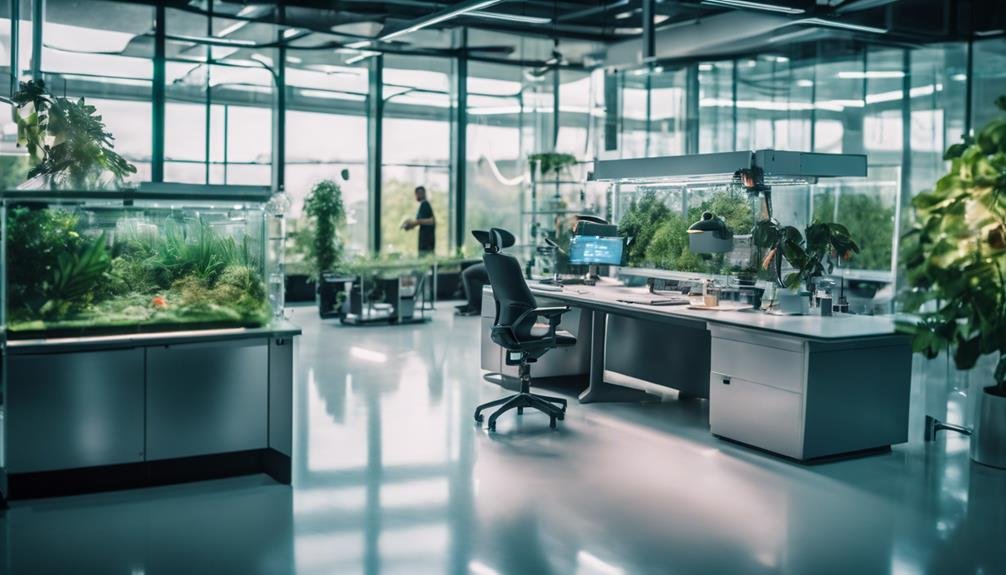Revolutionizing Workspaces: Life Sciences' Tomorrow's Design Insights
In the ever-evolving realm of life sciences, the evolution of workspaces stands as a critical enabler of progress and innovation.
Tomorrow's design insights promise to redefine the traditional paradigms of workplace functionality by incorporating elements that align with organizational objectives.
From cutting-edge technologies to innovative spatial utilization strategies, the landscape is poised for a shift towards more dynamic and purpose-driven environments.
As the industry gears up for a new era of workplace transformation, the integration of advanced analytics and data-driven decision-making looms large as a driving force behind the reimagining of workspaces in the life sciences sector.
Key Takeaways
- Workplace design aligned with organizational strategy for enhanced collaboration and productivity.
- Employee experience enhancement through physical and virtual environments tailored to future needs.
- Future workplace strategy focused on agility, proximity, and flexibility for optimal performance.
- Utilization of analytics and data science to drive informed decisions and adapt to changing dynamics.
Workplace Design Alignment
In the realm of modern workspaces, the alignment of workplace design with organizational purpose, mission, and strategy is paramount for fostering productivity and innovation. Organizational strategy serves as the guiding force behind workplace purpose, shaping the physical environment to support the overall goals of the company.
By designing workspaces that reflect the organization's strategic objectives, companies can enhance employee engagement, collaboration, and performance. Understanding the workplace purpose within the larger organizational strategy allows for the creation of environments that not only meet the functional needs of employees but also inspire creativity and drive progress towards shared goals.
Strategic alignment between workplace design and organizational strategy is a cornerstone of success in today's dynamic business landscape.
Co-location in R&D Processes
Amidst the imperative of aligning workplace design with organizational strategy to optimize productivity and innovation, a pivotal focus emerges on the strategic incorporation of co-location in high-speed R&D processes within life sciences environments. Collaborative spaces where multidisciplinary teams work together can significantly enhance collaboration benefits and innovation acceleration.
The physical proximity of researchers, scientists, and engineers promotes spontaneous interactions and idea exchanges, leading to quicker problem-solving and innovation. This synergy fosters a dynamic environment where knowledge sharing is seamless and collective intelligence thrives, ultimately propelling R&D projects forward at an accelerated pace.
Reconfigurable Smart Lab Equipment
Within the realm of life sciences' workspace evolution, the integration of reconfigurable smart lab equipment emerges as a strategic imperative for fostering adaptable and collaborative research environments. Enhanced collaboration is facilitated through the utilization of smart technology innovation, allowing for seamless adjustments to equipment configurations based on evolving research needs. These advancements not only promote flexibility but also drive efficiency by optimizing resource utilization within laboratories.
Activity-Based Design Strategies
The integration of activity-based design strategies into life sciences' workspaces further enhances collaboration and productivity, building upon the foundation of reconfigurable smart lab equipment's adaptable and efficient research environments. By implementing these strategies, workspaces can be optimized to cater to specific tasks and work styles, promoting a more dynamic and interactive environment.
Key aspects include:
- Flexibility: Spaces are designed to cater to different activities, allowing employees to choose the most suitable environment for their tasks.
- Collaboration Zones: Dedicated areas for team collaboration encourage idea-sharing and innovation.
- Productivity Enhancements: Designing workspaces to support focused work as well as interactive sessions can lead to increased efficiency and output.
These strategies contribute to enhanced collaboration and workspace efficiency, fostering a more engaging and productive work environment.
Modular and Agile Solutions
Utilizing modular and agile solutions in workspace design presents a strategic approach to adaptability and efficiency in response to evolving team needs and organizational dynamics. Modular flexibility allows for the customization of workspaces to suit specific requirements, promoting collaboration, innovation, and productivity. Agile collaboration, facilitated by adaptable spaces, encourages dynamic interactions and quick adjustments to changing project demands. By integrating modular elements and agile methodologies, organizations can create work environments that are responsive to evolving challenges and opportunities, fostering a culture of flexibility and creativity. The table below illustrates the key benefits of modular flexibility and agile collaboration in workspace design.
| Modular Flexibility | Agile Collaboration |
|---|---|
| Customizable workspaces | Dynamic interactions |
| Promotes innovation | Quick adjustments |
| Enhances productivity | Responsive to project needs |
Employee Experience Enhancement
Enhancing the employee experience through strategic workplace design interventions is pivotal for fostering a culture of innovation and productivity. In today's dynamic work environment, organizations are focusing on integrating remote work options to enhance employee engagement.
Well-being initiatives are being prioritized to ensure employees feel supported and valued, contributing to a positive work environment. Virtual collaboration tools are being leveraged to facilitate seamless communication and teamwork among geographically dispersed teams.
These initiatives not only improve employee satisfaction but also have a direct impact on overall productivity and creativity within the workspace. By aligning design strategies with employee needs and preferences, companies can create a thriving work environment that fosters growth and success.
Virtual Environments Development
Building upon the foundation of enhancing the employee experience through strategic workplace design, the exploration of Virtual Environments Development introduces a new dimension to modern workspace innovation and connectivity.
Collaborative innovation takes center stage as virtual environments foster teamwork and creativity in unprecedented ways. By creating immersive experiences, employees can engage with their work on a deeper level, driving productivity and innovation.
These virtual spaces offer a platform for dynamic interactions, enabling seamless collaboration regardless of physical location. The integration of virtual environments into the workspace design not only enhances connectivity but also opens up possibilities for new ways of working together.
Embracing this innovative approach paves the way for a more agile and interconnected workforce, revolutionizing traditional work dynamics.
Future Workplace Ecosystem
In the realm of modern workspace transformation, the concept of the Future Workplace Ecosystem emerges as a strategic blueprint for fostering dynamic organizational connectivity and adaptability. This innovative approach emphasizes collaborative innovation and employee engagement to create a thriving work environment that promotes creativity and productivity.
- Enhanced Collaboration: Implementing collaborative spaces and digital tools to encourage teamwork and innovation.
- Flexible Work Arrangements: Offering remote work options and flexible schedules to enhance employee engagement and satisfaction.
- Technology Integration: Leveraging advanced technologies to streamline processes and facilitate seamless communication among team members.
Shorter-Term Leases Consideration
Amid the evolving landscape of workplace design and real estate management, the consideration of shorter-term leases has emerged as a pivotal strategy for organizations seeking flexibility and adaptability in their workspace arrangements.
Flexible leasing options enable companies to adjust their space requirements based on evolving needs without being tied down by long-term commitments. By embracing shorter-term leases, organizations can swiftly respond to changing market conditions, scale operations as necessary, and experiment with different office layouts to enhance productivity and collaboration.
This approach fosters workspace adaptability, allowing for a dynamic environment that can easily accommodate shifting team structures and project requirements. Embracing this strategy aligns with the modern ethos of agile business practices and supports a more responsive real estate portfolio.
Analytics and Data Utilization
Considering the evolving landscape of workplace design and real estate management, the strategic utilization of analytics and data has become increasingly imperative in quantifying the needs of diverse teams and fostering adaptive workspace solutions.
Data-driven decision-making allows organizations to tailor their workspace environments effectively. Utilizing predictive analytics technologies enables proactive adjustments to space configurations based on anticipated needs.
Conclusion
In conclusion, the future of workspaces in the life sciences sector is being shaped by a strategic alignment of design with organizational goals, emphasizing collaboration, adaptability, and employee experience enhancement.
Through the integration of advanced analytics, reconfigurable smart lab equipment, and modular solutions, tomorrow's workspaces will foster innovation and productivity.
The shift towards customer-centric designs and flexible real estate solutions reflects a dynamic and evolving workplace ecosystem driven by data utilization and strategic planning.







